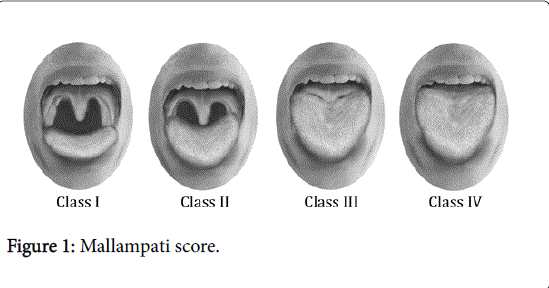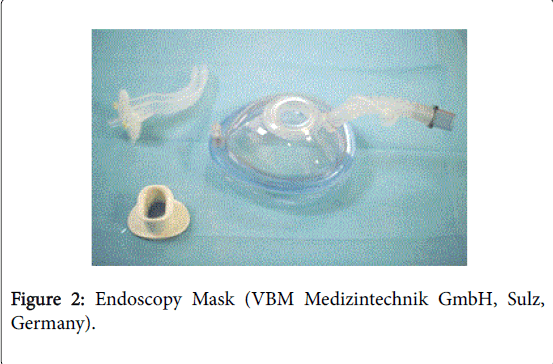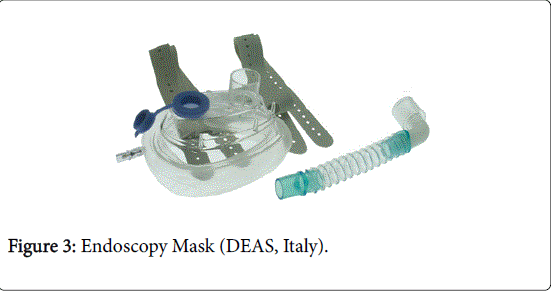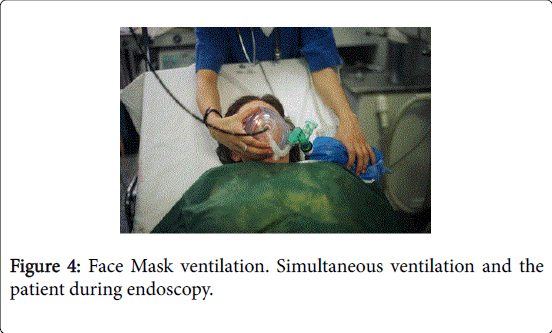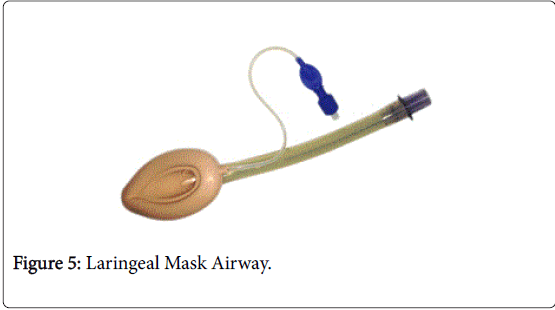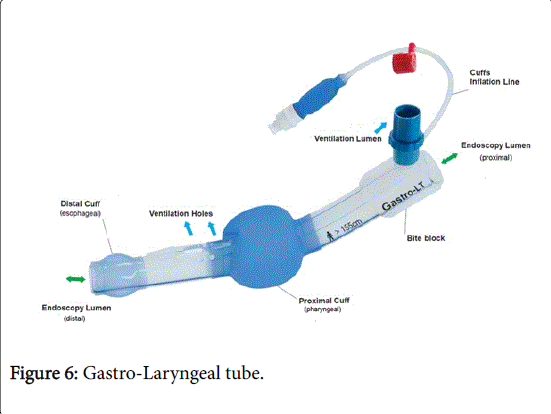Review Article Open Access
Hot Topics in Airway Management During Gastrointestinal Endoscopy
Annarita Torino, Daniela Di Martino, Pierluigi Fusco, Umberto Collina, Lucia Marullo and Fausto Ferraro*Department of Anesthesiological, Surgical and Emergency Sciences, Second University of Naples, Italy, Postcode: 80138, Italy
- *Corresponding Author:
- Fausto Ferraro
MD, Assistant Professor of Anesthesiology, Dept. of Anaesthesiological
Surgical and Emergency Sciences, Second University of Naples
SUN, Piazza Miraglia, 2, 80138 Naples, Italy
Tel: 39-081-5665172
Fax: 39- 081- 5666600
E-mail: fausto.ferraro@unina2.it
Received date: October 06, 2015, Accepted date: January 05, 2016, Published date: January 12, 2016
Citation: Torino A, Martino DD, Fusco P, Collina U, Marullo L, et al. (2016) Hot Topics in Airway Management During Gastrointestinal Endoscopy. J Gastrointest Dig Syst 6:377. doi:10.4172/2161-069X.1000377
Copyright: © 2016 Torino A, et al. This is an open-access article distributed under the terms of the Creative Commons Attribution License, which permits unrestricted use, distribution, and reproduction in any medium, provided the original author and source are credited.
Visit for more related articles at Journal of Gastrointestinal & Digestive System
Abstract
Recently, endoscopic minimal invasive procedures have become commonly practiced. Sedation, and consequently airways management, is a way to respond to the increasing complexity and duration of gastrointestinal endoscopy. Main issues regarding the sedation during gastrointestinal endoscopy are: patient’s safety, comfort and tolerance to the procedure. This results simultaneously in a good examination quality. The best method to assure airways safety is still debated; it should always be tailored to the patient, to his comorbidity and to the particular procedure to be done, and has to be accepted by the whole medical team. This article provides an update on the available devices and methods of airway management during gastrointestinal endoscopy.
Keywords
Gastrointestinal endoscopy; Airway management; Endoscopy mask; Gastro laryngeal tube; Laryngeal mask airway; Robertazzi nasopharyngeal airway; Endotracheal tube
Introduction
In the last decades gastrointestinal endoscopy has become a commonly used minimal invasive procedure in the clinical practice. Based on the different complexity level of the operative endoscopic procedures the role of sedation is getting increasingly relevant.
Sedation is a drug induced consciousness depression which aim is to relieve patient’s anxiety and pain, and to induce amnesia of the intervention in order to improve the examination’s outcome and the patient’s compliace [1,2].
Sedation may be classified in four stages: minimal, moderate, deep sedation and general anesthesia (Table 1); they correspond to different stages of consciousness, airway protective reflexes and respiratory function impairment. Since the operatory field is shared with the endoscopist, a dedicated airway management is mandatory when deep sedation or general anesthesia are necessary [3].
| Minimal sedation (anxiolysis) | Moderate sedation (conscious sedation) | Deep sedation | General anesthesia | |
| Responsiveness | Normal response to verbal stimulation | Purposeful response to verbal or tactile stimulation | Purposeful response after repeated or painful stimulation | Unarousable even with painful stimulus |
| Airway | Unaffected | No intervention required | Intervention may be required | Intervention often required |
| Spontaneous ventilation | Unaffected | Adequate | May be inadequate | Frequently inadequate |
| Cardiovascular function | Unaffected | Usually mantained | Usually mantained | May be impaired |
Table 1: Levels of sedation and anesthesia.
This is to avoid procedural complicances such as: hypoxia, hypercapnia and aspiration of gastric contents [4,5]. To choice the sedation stage it is necessary to consider patient dependent variables, procedure dependent variables and operator dependent variables [6] showed in Table 2.
| Patient dependent variables | Procedure dependent variables | Operator dependent variables |
| Age | Invasiveness level | Duration |
| State of health | Discomfort | Skills |
| Comorbidity | Duration | |
| Level of anxiety | Decubitus | |
| Pain tolerance | Need of immobility | |
| ASA score | Stimulation of reflexive areas | |
| Collaborate capability |
Table 2: Patient, procedure, and operator dependent variables affecting the sedation stage.
Generally, quick and easy diagnostic and therapeutic procedures are easily performed in moderate sedation. Deeper stages of sedation are needed to allow more difficult, painful and longer interventions, such as ERCP.
In addition, when moderate sedation becomes inadequate because of procedural variables, and/or patient’s management is difficult, deep sedation and general anesthesia should be used without any hesitation [2,7]. Although a standard protocol does not already exist, a strategy tailored on every single clinic setting could be considered the best strategy. This method allows a good quality of the procedure and improves patient’s compliance, thus determining patient’s and physician’s satisfaction [8].
Conscious sedation
During moderate sedation, also called "conscious sedation” (Table 1), the airways protective reflexes are preserved [4] and so, dedicated airway management devices could be unnecessary. According to the SpO2 monitoring, the enrichment of the inspired air with low oxygen flux through nasal cannulas could be provided. This stage of sedation is the most used to perform minimally invasive and quick endoscopic procedures.
Deep sedation and general anesthesia
During these stages of sedation (Table 1) the airway protective reflexes and respiratory function are impaired [1]. Thus, airway management with dedicated devices is needed. This clinical setting requires anesthesiological skills. Deep sedation and general anesthesia are indicated in lengthy and/or invasive procedures and in poorly compliant patients [2,4].
Airway Management
A correct, proper and safe airway management begins with the evaluation of the patient's medical history, of his comorbidity, his bodily habitus, and his anthropometric parameters predictive of difficult airway. The ASA Task Force [1] proposed a list of prognostic factors of suspected difficult airway (Table 3).
| Congenital or acquired disease of the nose, tongue, theet, temporomandibular joint and cervical spine Previous narcosis with and without endotracheal intubation Obesity, snoring and obstructive sleep apnea Previous tracheotomyPrevious prolonged intubation and/or difficult airway report |
Table 3: Evaluation of prognostic factor of suspected difficult airway.
Specific anthropometric parameters, predictive of difficult airway, are shown in Table 4. Mallampati score (Figure 1) is a high precision predictive indicator of difficult intubation. It evaluates the possibility to visualize: the base of theuvula, faucial pillars and soft palate. These are related to the patient's anatomical features, and to the difficulty level of airway management that will be find at the laryngoscopy.
| Mobility of the neck and its shape Mandibular hypoplasia or micrognathia Mobility of the temporomandibular joint Interdental distance Conditions of theet, denture fixed or mobile, protrusion of the incisors, dimension of the tongue in relation to the oral cavity ChinTyroid Distance Mallampati score Mandibular protrusion test Chin-Sternum distance |
Table 4: Anthropometric parameters predictive of difficult airway.
Difficulty levels increase from the Class I to the Class IV [9]. The expectation of difficult or impossible endotracheal intubation can be based on the severe divergence from the norm of just one parameter or on the mild but concurrent alteration of more parameters [10-12].
Airway Management Devices
Airway management devices in gastrointestinal endoscopy are listed in Table 5.
| Face Mask Ventilation: Endoscopy Mask (VBM Medizintechnik GmbH; DEAS) |
| Supraglottic devices: Robertazzi nasopharyngeal airway Laryngeal Mask Airway Gastro Laryngeal Tube (VBM Medizintechnik GmbH) |
| Endotracheal Tube Not armored Armored |
Table 5: Airway management devices in gastrointestinal endoscopy.
Endoscopy Mask (VBM Medizintechnik GmbH, Sulz, Germany; DEAS, Italy)
Face Mask ventilation [13-15] (Figures 2-4) is a device that allows simultaneous ventilation of the patient during Fiberoptic Intubation, Bronchoscopy, GI Endoscopy procedures, Trans-Esophageal Echocardiography [13,16]. It increases the patient comfort and the quality of the procedure; it is ideal for diagnostic endoscopic procedures of short duration [16,17]. This kind of mask is provided of a specifically designed Guedel and biteblock to protect equipment from damage, it is for single use without any risk of infection or contamination, it is available in different sizes.
This device allows application of continuous positive airway pressure (CPAP) [18] to prevent or overcome obstruction and airways collapse during sedation for upper endoscopy [19]. Ventilation through this device has been compared with spontaneous ventilation via nasal insufflations, in a prospective study conducted in patients receiving propofol sedation [20]. Results showed fewer episodes of oxygen desaturation in the Endoscopy Mask group. In pediatric patients undergoing upper gastrointestinal endoscopy, this kind of mask allows to administer inhalational anesthetic drugs [21]. Using this kind of mask it could be necessary to use lubricants to avoid drag. Silicone lubricants, such as EndoLubeTM, are preferable to waterbased products which rapidly dries to a thin film. The endoscope should always be preloaded through the mask before the procedure; then the patient should be preoxygenate using a standard mask and once he is ready, the endoscope can pass into the esophagus and the mask can be fixed to the patient’s face. Once operators have reached familiarity with endoscopy mask in easy cases, their use should be reserved for selected cases in reason of their high cost. It doesn’t require anesthesiological improved skills.
Robertazzi nasopharyngeal airway
It is a simple supraglottic device used to deliver high oxygen flow through the nasopharynx; it could be positioned after topical anesthesia or when the patient is already sedated. It consists of a nasopharyngeal cannula, an oxygen connector and a strap from a bite block necessary to avoid its dislodgment [22]. It has different sizes; choosing the right size avoids wrong positioning related problems such as failure when a short airway does not pass the velopharynx, or such as cough or laryngospasm when a long airway contacts vocal cords or arytenoids. This system is highly helpful in reducing the episodes of oxygen desaturation during endoscopy [22]; Müller et al. in their prospective, randomized trial conclude that the routine placement of a nasopharyngeal airway can reduce the frequency of hypoxemic events during endoscopic sedation with minor risks for nasopharyngeal injury [23].
Laryngeal mask airway
Laryngeal Mask Airway (LMA) is a supraglottic airway device. It is a plastic tube with a distensible oval cuff at the end; it is placed through the mouth with its tip in the lower pharynx just close to the upper oesophageal sphincter. In this way it is possible to seal the larynx without crossing the glottis (Figure 5). In a meta-analysis conducted earlier in 1995 by Brimacombe at al., endotracheal tube was considered as the gold standard to protect airways during gastroscopy, although they had already found the same frequency of lung aspiration both with the endotracheal tube than with the LMA in selected cases [24]. In more recent comparative study between the use of LMA versus Endotracheal Tube during endoscopic retrograde cholangiopancreatography (ERCP), using a 13 mm diameter endoscope, Osborn et al. [25] did not notice significant differences, except for the extubation time that resulted shorter for the LMA. According to this study, LMA can be advantageously used in endoscopic procedures without any obstacle to the endoscope insertion and displacement problems. After its placement, the LMA is moved to the left side of the mouth, then the endoscopist puts a classic bite block into the right side of the mouth; bite block allows the endoscope to pass through the mouth without any risk of its damage by teeth. Once the endoscope is inserted, it should move past the LMA and then into the oesophagus [25]. During this procedure, the operator should search for the tip of the LMA which lies in the upper oesophageal sphincter. To avoid drag and out movement of the device, it is recommended to use silicone lubricated gastroscope. In pediatric patients the LMA has been successfully used during endoscopy upper procedures performed with small diameter gastroscope [26,27]. The LMA, such as the other supraglottic devices, has the advantage of avoiding intubation’s stress and the need of neuromuscular blocking drugs, of decreasing anesthetic dose, extubation, recovery and discharge time [28,29]. Furthermore the LMA can be reusable after adequate sterilization and it does not require improved anesthesiological skills [30].
On the basis of the quoted studies, we can assert that the airway management with LMA is safe and effective. Although, in patients at high risk of vomiting, such as full stomach, LMA and other extraglottic devices do not exclude the risk of inhalation [31]. In these cases, the endotracheal tube should be preferred.
Gastro laryngeal tube (VBM Medizintechnik GmbH, Sulz, Germany )
Gastro Laryngeal Tube (Figure 6) is a supraglottic airway device for ventilation, specifical for gastro intestinal endoscopy use, it is used to assure airway patency in adults in spontaneous breathing or under mechanical ventilation when deep sedation or general anesthesia are needed for complex gastrointestinal endoscopic procedures. It is provided of two channels, one for ventilation and one for the passage of the gastroscope. It has a proximal cuff that stabilizes the tube, it is placed in the pharynx and occludes the oropharynx and nasopharynx, and a distal cuff that occludes the oesophagus preventing pulmonary aspiration [31]. Since the two high-volume, low-pressure cuffs are interconnetted, they are inflated by a single valve placed on the pilot balloon until reaching a pressure of 60 cmH20. The Gastro Laryngeal Tube is a latex free silicone tube, it has an endoscopic channel with an inner diameter of 16 mm that allows the passage of a maximum 13.8 mm diameter endoscope, this channel is coated with a polymer that facilitates the sliding of the endoscope [32]. Gaitini et al. [32] and Fabbri et al. [33] retain the manoeuvrability of the endoscope agile in all patients. The Gastro Laryngeal Tube is one size and it is suitable only for >155 cm tall patients. It has to be placed with the patient lying supine, with the head in neutral or sniffing position. The tube has to be introduced following the midline of the mouth with the distal part leaned on the hard palate and pushed down until reaching the hypopharynx [34]. At this point the distal part should be directed into the oesophagus by the left index finger. After placement the cuffs are bloated to a pressure of 60 cm H2O. Correct insertion of the Gastro Laryngeal Tube is verified through symmetric chest expansion, auscultation, lack of gastric insufflation and by capnography [32]. The airway is effective and adequate if it is possible to obtain an 8-10 ml/kg of volume during soft manual ventilation [32]. The Gastro Laryngeal Tube has the advantages of not requiring neuromuscular blocking drugs, of not subjecting the patient to direct laryngoscopy with all its possible hemodynamic consequences; it allows both spontaneous and mechanical ventilation, it protects the airways from reflux or inhalation of gastric content, it reduces extubation, recovery and discharging time and it does not require improved anesthesiological skills for positioning.
Endotracheal tube
The endotracheal tube is a polyvinyl chloride (PVC) tube with a low pressure and high volume cuff at its end. The clinic use of the tube is usually decided considering the base of the internal diameter which limits the air flux. The factor that bounds the choice of the size is the grading of the rim of the glottis in adults and the underglottis region in children. They are product with scale measures of 0.5 mm of the internal diameter starting from 2.5 to 9.0 mm. The depth suggested for the positioning, referred to the point of the tube, must be evaluated in every patient in order to the wide variability in the length of the windpipe. To facilitate the right positioning of the tube there is a radiopaque line over the cuff that should be placed immediately after the vocal cords. Once the tube has been inserted, the cuff must be inflated to give the right airways protection without any lateral compression of the trachea. The armored endotracheal tubes are wirereinforced tubes, they are are quite flexible but yet difficult to compress or kink. Their use is reserved to surgical procedures of the head or the neck or anytime when there is a serious probability of kneeling. In males an 8.0 mm diameter endotracheal is suggested, in females a 7.0 mm diameter is preferred, since females glottis is usually smaller. The tube size in the pediatric patients can be evaluated by the formula 16 plus Age/4. General anesthesia and neuromuscular blocking drugs are needed to get the tracheal intubation properly, and to perform this procedure improved anesthesiological skills such as confidence with the use of laryngoscopes and fibroscopes are necessary [30]. The times of induction, awakening, recovery room and discharging are longer than other airway management procedures, but, nowadays it is the standard for airways protection from the risk of lung aspiration [31].
Table 6 resumes different authors’ use of airways devices in children or adults according to endoscopic procedure, level of sedation and anesthesiological skills of the operators.
| Authors | Ref | Year | Endoscopic Procedure | Population | Level of sedation | Administration of sedation | Airway Device |
| Gajraj NM | [25] | 1996 | EGDS | Children | Moderate | Anesthesiologist | Laryngeal Mask Airway |
| Osborn | [23] | 2002 | ERCP | Adults | Deep | Anesthesiologist | Laryngeal Mask Airway |
| Orfei P | [26] | 2002 | EGDS | Children | Moderate | Anesthesiologist | Laryngeal Mask Airway |
| Rauch RY | [20] | 2003 | EGDS | Children | Deep | Anesthesiologist | Endoscopy mask |
| Gaitini LA | [30] | 2010 | ERCP | Adults | Deep | Anesthesiologist | Gastro-Laryngeal Tube |
| Fabbri C | [31] | 2012 | ERCP | Adults | Deep | Anesthesiologist | Gastro-Laryngeal Tube |
| Muller M | [22] | 2014 | Colonscopy and EGDS | Adults | Conscious sedation | Non- Anesthesiologist | Nasopharyngeal Airway |
Table 6: Resume of authors’ use of airways devices according to endoscopic procedure and level of sedation.
Discussion
Conclusion
Until today there is no validated protocol of sedation and consequent airway management standardized to the endoscopic procedure to perform. As we have already reported, the necessity of different depth sedation, and the consequent airway management is influenced by a lot of variables: patient, procedure and operator dependent. Considering all the factors listed above, it would be better to adopt a procedure of close collaboration and communication between the anesthetist, the operator and the patient. It would be also necessary to consider the procedure to be done, its invasiveness (pain, reflex stimulation, bleeding, duration) but also patient’s special needs, his comorbidities, his bodily habitus and, last but not least, his will and his compliance. So, after a careful clinic evaluation of the patient from the anesthetist and from the endoscopist, the first step is the risk stratification. Then, there is the need to elaborate a tailored therapeutic and operative therapy, adapt to the single procedure and the single patient. Although at our knowledge there are no specific evidence based procedures, we should know, have available and use the different airway management devices and we should consider the wide selection of therapeutic options at our disposal. This could lead to maximize the positive outcome and to avoid or, in any case, to reduce the complications related to every gastrointestinal endoscopic procedure. For these reasons we believe that the airway management should not be left to chance but it must be placed in the foreground and it should be methodologically programmed by including it in the protocol of every endoscopic procedure.
Conflict of Interest
Annarita Torino, Daniela Di Martino, Pierluigi Fusco, Umberto Collina, Lucia Marullo and Fausto Ferraro have not received fees for serving as a speaker, they have not received research funding from any organization. They do not own stocks and/or shares in any organization. They do not own patents.
References
- American Society of Anesthesiologists Task Force on Sedation and Analgesia by Non-Anesthesiologists (2002) Practice guidelines for sedation and analgesia by non-anesthesiologists. below Anesthesiology 96: 1004-1017.
- Faigel DO, Baron TH, Goldstein JL, Hirota WK, Jacobson BC, et al. (2002) Guidelines for the use of deep sedation and anesthesia for GI endoscopy. below Gastrointest Endosc 56: 613-617.
- Godwin SA, Caro DA, Wolf SJ, Jagoda AS, Charles R, et al. (2005) Clinical policy: procedural sedation and analgesia in the emergency department. below Ann Emerg Med 45: 177-196.
- Cohen LB, Delegge MH, Aisenberg J, Brill JV, Inadomi JM, et al. (2007) AGA Institute review of endoscopic sedation. below Gastroenterology 133: 675-701.
- Cook TM, MacDougall-Davis SR (2012) Complications and failure of airway management. below Br J Anaesth 109 Suppl 1: i68-68i85.
- Standards of Practice Committee, Lichtenstein DR, Jagannath S, Baron TH, Anderson MA, et al. (2008) Sedation and anesthesia in GI endoscopy. below Gastrointest Endosc 68: 205-216.
- Lee H, Kim JH (2009) Superiority of split dose midazolam as conscious sedation for outpatient colonoscopy. below World J Gastroenterol 15: 3783-3787.
- Bell GD (2004) Preparation, premedication, and surveillance. below Endoscopy 36: 23-31.
- Lee A, Fan LT, Gin T, Karmakar MK, Ngan Kee WD (2006) A systematic review (meta-analysis) of the accuracy of the Mallampati tests to predict the difficult airway. below Anesth Analg 102: 1867-1878.
- American Society of Anesthesiologists Task Force on Management of the Difficult Airway (2003) Practice guidelines for management of the difficult airway: an updated report by the American Society of Anesthesiologists Task Force on Management of the Difficult Airway. below Anesthesiology 98: 1269-1277.
- Apfelbaum JL, Hagberg CA, Caplan RA, Blitt CD, Connis RT, et al. (2013) Practice guidelines for management of the difficult airway: an updated report by the American Society of Anesthesiologists Task Force on Management of the Difficult Airway. below Anesthesiology 118: 251-270.
- Shiga T, Wajima Z, Inoue T, Sakamoto A (2005) Predicting difficult intubation in apparently normal patients: a meta-analysis of bedside screening test performance. below Anesthesiology 103: 429-437.
- Hagberg CA, Gabel JC (2013) Current Concepts in The Management of the Difficult Airway. Anesthesiology News.
- VBM Medizintechnik GmbH. ANESTHESIA & INTENSIVE CARE Catalogue.
- DEAS. Product Catalogue.
- Shiga T, Inoue T, Wajima Z, Ogawa R (2002) Insertion of the transesophageal echocardiography probe via endoscopy mask. below Anesth Analg 95: 561-563, table of contents.
- Rauch RY, Brener CE (2003) Airway management for pediatric esophagogastroduodenoscopy using an endoscopy mask. below Anesth Analg 96: 303-304.
- Cabrini L, Nobile L, Cama E, Borghi G, Pieri M, et al. (2013) Non-invasive ventilation during upper endoscopies in adult patients. A systematic review. below Minerva Anestesiol 79: 683-694.
- Antonelli M (2002) Noninvasive positive-pressure ventilation vs. conventional oxygen supplementation in hypoxemic patients undergoing diagnostic bronchoscopy. 121: 1149-54.
- Bourgain JL, Billard V, Cros AM (2007) Pressure support ventilation during fiberoptic intubation under propofol anaesthesia. British Journal of Anaesth 98:136-140.
- Rauch RY, Brener CE (2003) Airway management for pediatric esophagogastroduodenoscopy using an endoscopy mask. below Anesth Analg 96: 303-304.
- Mandel JE (2009) Airway appliances in endoscopy. Techniques in Gastrointestinal Endoscopy 11:188-191.
- Müller M, Wehrmann T, Eckardt AJ (2014) Prospective Evaluation of the Routine Use of a Nasopharyngeal Airway during Endoscopic Propofol-Based Sedation. Digestion 89:247-252.
- Brimacombe JR, Berry A (1995) The incidence of aspiration associated with the laryngeal mask airway: a meta-analysis of published literature. below J Clin Anesth 7: 297-305.
- Osborn I, Cohen J, Soper RJ(2002) Laryngeal mask airway-a novel method of airway protection during ERCP: comparison with endotracheal intubation. Gastrointestinal Endoscopy 56:122.
- Gajraj NM (1996) Use of the laryngeal mask airway during oesophago-gastro-duodenoscopy. below Anaesthesia 51: 991.
- Orfei P, Ferri F, Panella I, Meloncelli S, Patrizio AP, et al. (2002) [The use of laryngeal mask airway in esophagogastroduodenoscopy in children]. below Minerva Anestesiol 68: 77-82.
- Cork R, Depa RM, Standen JR (1994) Prospective comparison of use of the laryngeal mask and endotracheal tube for ambulatory surgery. below Anesth Analg 79: 719-727.
- Brimacombe JR, Berry A (1995) The incidence of aspiration associated with the laryngeal mask airway: a meta-analysis of published literature. below J Clin Anesth 7: 297-305.
- Goliasch G, Ruetzler A, Fischer H (2013) Evaluation of advanced airway management in absolutely inexperienced hands: a randomized manikin trial. European Journal Of Emergency Medicine: Official Journal Of The European Society For Emergency Medicine [Eur J Emerg Med]20: 310-314.
- Petrini F, Accorsi A, Adrario E, Agrò F, Amicucci G, et al . (2005) Gruppo di Studio SIAARTI "Vie Aeree Difficili"; IRC e SARNePI; Task Force, Recommendations for airway control and difficult airway management. Minerva Anestesiol 71:617-657.
- Gaitini LA, Lavi A, Stermer E, Charco Mora P, Pott LM, et al. (2010) Gastro-Laryngeal Tube for endoscopic retrograde cholangiopancreatography: a preliminary report. below Anaesthesia 65: 1114-1118.
- Fabbri C, Luigiano C, Cennamo V (2012) The Gastro-Laryngeal Tube for interventional endoscopic biliopancreatic procedures in anesthetized patients. Endoscopy 44 :1051-1054.
- Ocker H, Semmel T (2010) VBM Medizintechnik GbmH.
Relevant Topics
- Constipation
- Digestive Enzymes
- Endoscopy
- Epigastric Pain
- Gall Bladder
- Gastric Cancer
- Gastrointestinal Bleeding
- Gastrointestinal Hormones
- Gastrointestinal Infections
- Gastrointestinal Inflammation
- Gastrointestinal Pathology
- Gastrointestinal Pharmacology
- Gastrointestinal Radiology
- Gastrointestinal Surgery
- Gastrointestinal Tuberculosis
- GIST Sarcoma
- Intestinal Blockage
- Pancreas
- Salivary Glands
- Stomach Bloating
- Stomach Cramps
- Stomach Disorders
- Stomach Ulcer
Recommended Journals
Article Tools
Article Usage
- Total views: 19666
- [From(publication date):
February-2016 - Apr 04, 2025] - Breakdown by view type
- HTML page views : 18504
- PDF downloads : 1162

